KTM 50 SX PRO JUNIOR LC, 50 SX PRO SENIOR LC User Manual
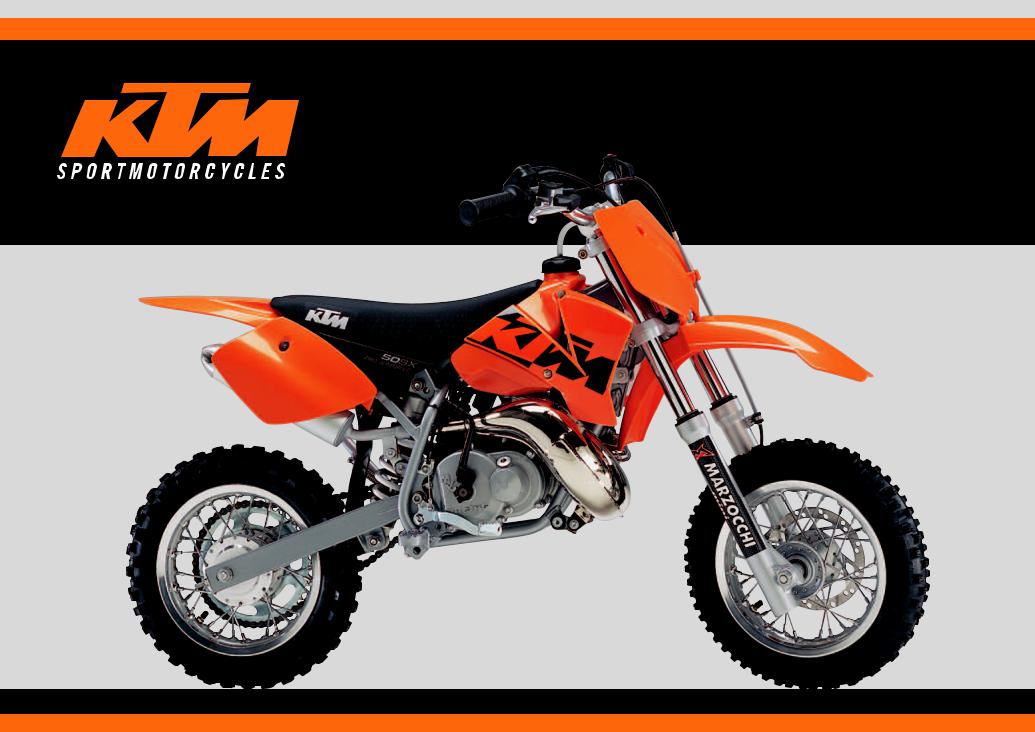
50 SX PRO JUNIOR LC, 50 SX PRO SENIOR LC
BEDIENUNGSANLEITUNG
OWNER’S MANUAL
MANUALE D’USO MANUEL D’UTILISATION MANUAL DE INSTRUCCIONES
2003
Art.Nr. 3.210.46 4/2002
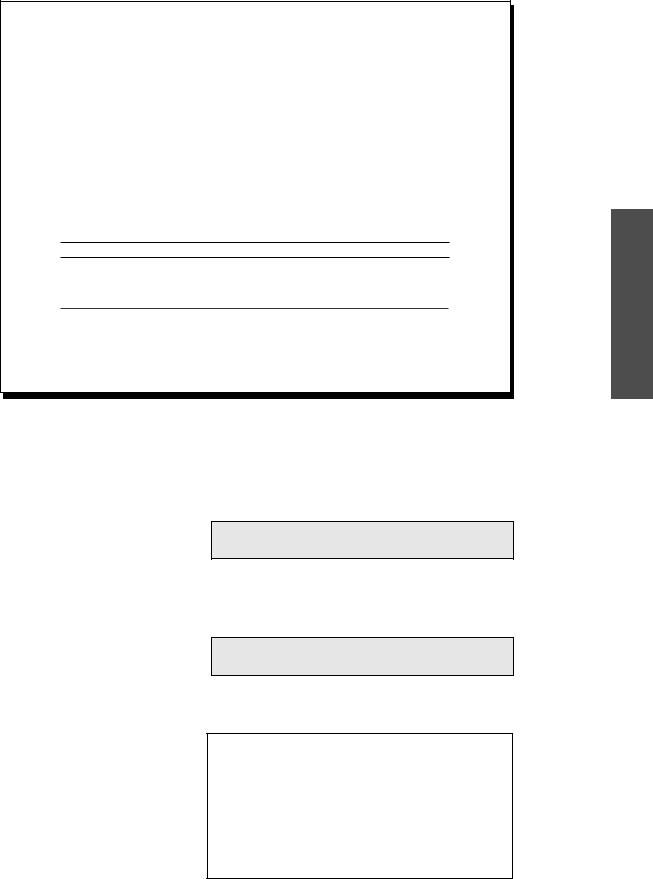
IMPORTANT
PLEASE READ THIS MANUAL THOROUGHLY BEFORE LETTING YOUR YOUNGSTER RIDE THE MOTORCYCLE FOR THE FIRST TIME. THIS MANUAL CONTAINS IMPORTANT INFORMATION AND RECOMMENDATIONS THAT WILL HELP YOU AND YOUR YOUNGSTER TO OPERATE AND HANDLE THE MOTORCYCLE PROPERLY.
IN THE INTEREST OF EVERYBODY INVOLVED, WE URGE YOU TO PAY PARTICULAR ATTENTION TO INSTRUCTIONS AND INFORMATION MARKED AS FOLLOWS:
WARNING
IGNORING THESE INSTRUCTIONS CAN BE DANGEROUS TO LIFE AND LIMB.
! |
CAUTION |
! |
IGNORING THESE INSTRUCTIONS MAY DAMAGE PARTS OF THE MOTORCYCLE OR IMPAIR THE MOTORCYCLE’S TRAFFIC SAFETY.
Please insert the serial numbers of the motorcycle below
Chassis number
Engine number
Stamp of dealer
KTM SPORTMOTORCYCLE AG RESERVES THE RIGHT TO MODIFY ANY EQUIPMENT, TECHNICAL SPECIFICATIONS, COLORS,
MATERIALS, SERVICES OFFERED AND RENDERED, AND THE LIKE SO AS TO ADAPT THEM TO LOCAL CONDITIONS WITHOUT PRIOR NOTICE ANNOUNCEMENT AND WITHOUT GIVING REASONS, OR TO CANCEL ANY OF THE ABOVE ITEMS WITHOUT SUB-
STITUTING THEM WITH OTHERS. IT SHALL BE ACCEPTABLE TO STOP MANUFACTURING A CERTAIN MODEL WITHOUT PREVIOUS ANNOUNCEMENT. IN THE EVENT OF SUCH MODIFICATIONS, PLEASE ASK YOUR LOCAL KTM DEALER FOR INFORMATION.
ENGLISH 1
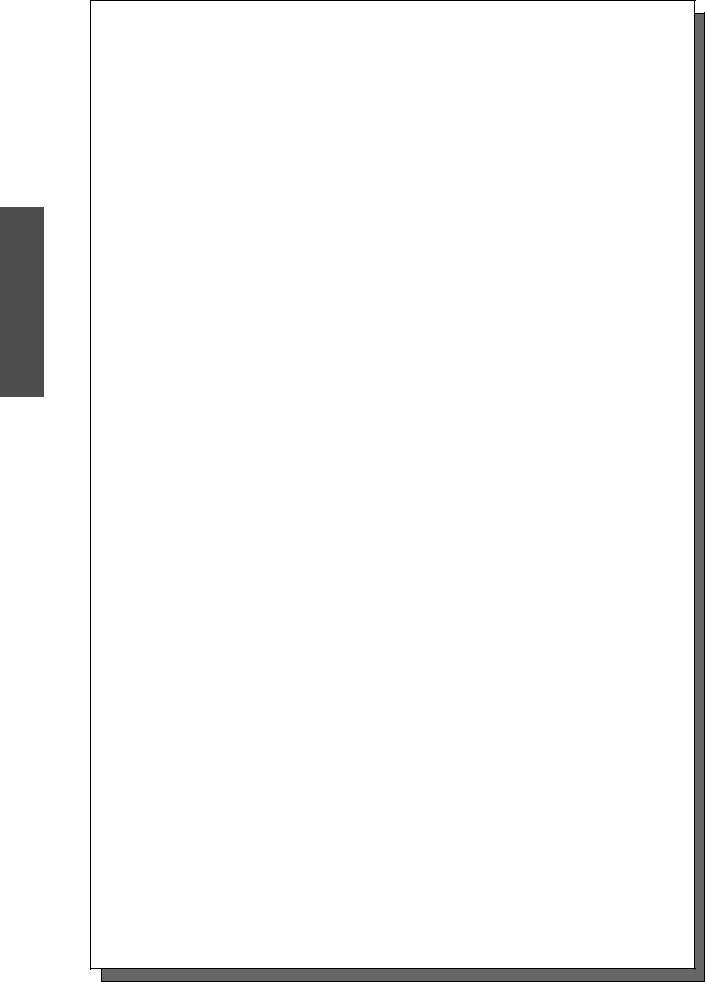
ENGLISH 2
Introduction
Now you own a modern motorcycle that you and your youngster will certainly enjoy, provided that you service and maintain it properly. This manual contains important information on the operation and maintenance of your new KTM motorcycle. It went to press describing your model’s latest state of development. Nevertheless, the descriptions may deviate slightly from the current design as our motorcycles are permanently improved.The Owner's Manual is an integral part of the motorcycle and must be handed over to the new owner when the motorcycle is sold.
We expressly point out that work marked with an asterisk (*) in the chapter "Maintenance work on the chassis and engine" must be performed by a KTM workshop. If maintenance work should become necessary during a competition, it must be performed by a trained mechanic.
Please strictly observe the prescribed running-in periods and inspection and maintenance intervals. Compliance with these instructions will significantly prolong the life of your motorcycle.
Be sure to have the maintenance work carried out by a KTM workshop to avoid losing your right to claim under the warranty.
For the safety of your child, only use spare parts and accessories approved by KTM. KTM shall not assume any liability for other products or consequential damage resulting from the use of such products.
When special needs arise, please contact a KTM dealer, who will seek the assistance of the KTM importer if necessary.
PARENTS SHOULD KEEP IN MIND that the safety of their youngsters always depends on the efforts made by the parents to ensure that the motorcycle is kept in good working order and only used on safe terrains. Nevertheless, driving the motorcycle, like driving any other vehicle, involves a potential risk. Therefore, please make sure that all fundamental precautions are taken. Please also read the „INFORMATION ON SAFE DRIVING FOR PARENTS“ on page 4.
Riding an off-highway motorcycle is a wonderful form of outdoor recreation and we certainly hope that you and your youngsters will enjoy it to the full. However, this enjoyable outdoor activity can cause environmental problems or lead to conflicts with other people. Responsible use of the motorcycle will prevent such problems and conflicts. You can contribute to securing the future of motorcycling by making sure that you and your youngsters only use the motorcycle within the limits established by the applicable laws, making environmental protection one of your top priorities and never violating other people’s rights.
In this spirit, we hope that you and your youngsters will always safely enjoy your motorcycle!
KTM SPORTMOTORCYCLE AG 5230 MATTIGHOFEN, AUSTRIA
Attachments: 1 spare parts manual chassis & engine
ALL RIGHTS RESERVED TO MAKE ALTERATIONS TO DESIGN AND MODEL.
© by KTM SPORTMOTORCYCLE AG, AUSTRIA All rights reserved
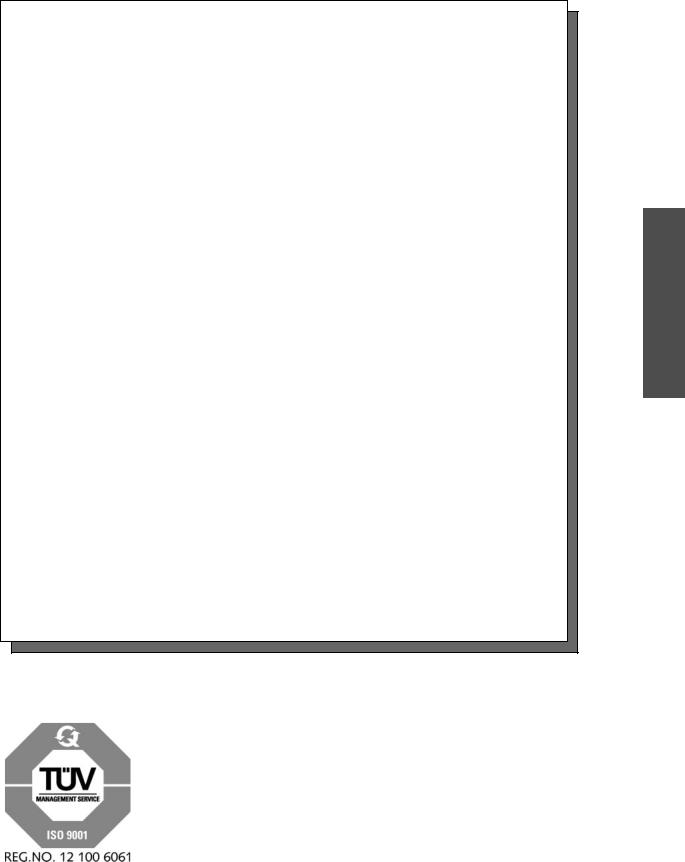
IMPORTANT WARRANTY AND
GUARANTEE INFORMATIONE
KTM mini-sports motorcycles are designed and constructed to resist the usual wear and tear of normal use in competitions.
The motorcycles comply with the regulations and categories currently in effect with the leading international motorcycle associations.
Observance of the service, maintenance and tuning instructions for the engine and chassis specified in the Owner's Manual is a prerequisite for faultless operation and the avoidance of premature wear. An improperly tuned chassis can lead to damage and breakage of the chassis components (see chapter on checking the basic chassis setting).
The service work specified in the "Lubrication and Maintenance Schedule" must be performed by a KTM workshop and recorded in the service manual otherwise claims under the warranty shall become void.
The fuels and lubricants specified in the Owner's Manual or automotive fluids with equivalent specifications must be used in accordance with the maintenance schedule.
No claims can be filed under the warranty for damage or consequential damage caused by manipulations or conversions to the motorcycle.
The use of the motorcycle under extreme conditions, e.g. on extremely muddy and wet terrain, can lead to higher than average wear on components such as the drive train or the brakes. In this case it may become necessary to service or replace wear parts before the service limit specified in the maintenance schedule has been reached.
In accordance with the international quality management ISO 9001 standard, KTM uses quality assurance processes that lead to the highest possible product quality.
ENGLISH 3
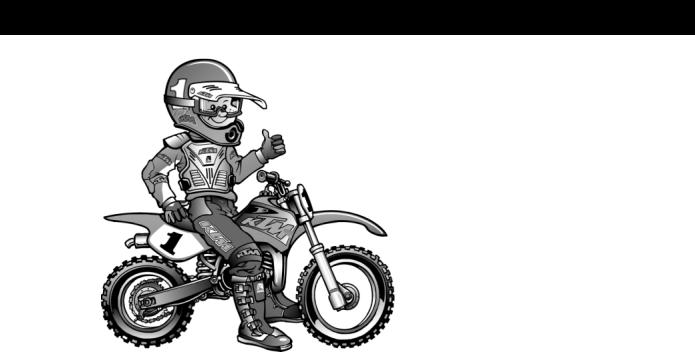
IMPORTANT INFORMATION FOR PARENTS ABOUT SAFE DRIVING
ENGLISH |
|
|
4 |
KTM mini motorcycles are off-road motorcycles designed for one person only. They are not allowed on public roads. |
|
|
||
|
The vehicle dimensions and components are designed for children from 6 to 10 years of age with a maximum |
|
|
weight of. 35 kg (78 lbs) and a maximum height of 130 cm (51 in). |
|
|
– |
Have your youngster wear proper protective gear whenever he or she rides the motorcycle: helmet, eye |
|
|
protection, chest, back, arm and leg protectors, gloves and boots. To set a good example, be sure to wear |
|
|
protective gear yourself whenever riding a motorcycle! |
|
– |
Before your youngster takes his or her first ride, explain how each of the controls works and check if your |
|
|
youngster has understood what you explained. We recommend to review the entire owner’s manual with |
|
|
your youngster item by item, paying particular attention to the specially marked warnings and pointing out |
|
|
the danger of injury. |
|
– Instruct your youngster about riding and falling techniques, explain how the motorcycle will respond to |
|
|
|
shifting of the rider’s weight, etc. |
|
– |
Before starting the motorcycle for the first time check whether the basic fork and shock absorber settings are |
|
|
suitable for your child's weight (see chapter on checking the basic chassis setting) |
|
– |
Before using the motorcycle you should always check all components for proper operation (see mainenance |
|
|
schedule). Have your youngster perform these technical checks himself / herself as well. |
|
– |
Whenever you go for a ride with your youngster, keep in mind that the speed should be adjusted to your |
|
|
youngster and not the other way around. |
|
– |
Your youngster must understand that all instructions he or she receives from you or any other supervising |
|
|
adult must be followed. |
|
– |
Your child must be physically ready to ride a motorcycle. This means that he or she must at least be able to |
|
|
ride a bicycle. Being good at sports that require fast reactions is an additional advantage. Your youngster |
|
|
should be strong enough to pick up the motorcycle after a fall. |
|
– Never demand too much of your youngster. Give him or her time to get used to the motorcycle and to |
|
|
|
improve his / her riding skills. Do not even consider letting your youngster participate in a race before |
|
|
his / her physical condition, riding skills and motivation have sufficiently developed. |
|
– |
Explain to your youngster that he / she should always adjust his / her riding speed to the local conditions as |
|
|
well as to his / her own riding skills and that excessive speed can cause falls and severe injuries. Always keep |
|
|
in mind that youngsters tend to underestimate dangers or fail to recognize them altogether. The riding speed |
|
|
must be reduced, in particular, on unknown terrain. |
|
– |
Never let your youngster ride the motorcycle without supervision. An adult should always be present. |
|
– |
The motorcycle is designed for one rider only. Your youngster is not allowed to transport a passenger. |
|
– When you go for a ride, somebody at home should always know where you are going and when you will |
|
|
|
be back. This makes it easier to send you help, should problems occur. |

TABLE OF CONTENTS
Page |
|
IMPORTANT WARRANTY AND GUARANTEE INFORMATIONE |
..3 |
IMPORTANT INFORMATION ON SAFE DRIVING |
|
FOR PARENTS ........................................................................ |
4 |
SERIAL NUMBER LOCATIONS ............................................... |
6 |
Chassis number .................................................................. |
6 |
Engine number, engine type .............................................. |
6 |
OPERATION INSTRUMENTS .................................................. |
6 |
Throttle grip ....................................................................... |
6 |
Hand brake lever................................................................ |
6 |
Short circuit button ............................................................ |
6 |
Filler cap............................................................................. |
7 |
Fuel tap.............................................................................. |
7 |
Choke (DELL’ORTO PHVA 14 DS)..................................... |
7 |
Choke (DELL’ORTO PHBG 19 BS) ..................................... |
7 |
Kickstarter .......................................................................... |
7 |
Foot brake lever ................................................................. |
8 |
Side stand .......................................................................... |
8 |
Plugin - Stand .................................................................... |
8 |
Rebound damping function of the shock absorber ............. |
8 |
GENERAL TIPS AND WARNINGS FOR STARTING THE |
|
MOTORCYCLE..................................................................... |
10 |
Instructions for the first ride ............................................. |
10 |
Running in ....................................................................... |
10 |
DRIVING INSTRUCTIONS .................................................... |
11 |
What you should check before each start ........................ |
11 |
Starting when engine is cold ............................................ |
12 |
Starting when engine is warm .......................................... |
12 |
What to do when the engine is “flooded“....................... |
12 |
Starting off....................................................................... |
12 |
Driving ............................................................................. |
12 |
Braking............................................................................. |
13 |
Stopping........................................................................... |
13 |
Refueling, fuel.................................................................. |
13 |
PERIODIC MAINTENANCE SCHEDULE ................................ |
14 |
MAINTENANCE WORK ON CHASSIS AND ENGINE ............ |
16 |
Removing the seat ........................................................... |
16 |
Checking and adjusting the steering head bearing (Junior) ... |
16 |
Checking and adjusting the steering head bearing (Senior)... |
17 |
Page |
|
How to change the handlebar position ............................. |
17 |
Basic suspension setup for the weight of the driver .......... |
18 |
To determine the sag of the shock absorber ..................... |
18 |
To determine the sag of the telescopic fork ...................... |
18 |
Telescopic fork maintenance ............................................. |
19 |
Changing the telescoping fork oil ..................................... |
19 |
Cleaning the dust scrabbers of the telescopic fork ............ |
20 |
Changing spring preloading of the shock absorber ........... |
20 |
Checking the chain tension ............................................... |
20 |
Correct chain tension ........................................................ |
20 |
Chain maintenance ........................................................... |
20 |
Generel information about KTM disc brakes ..................... |
21 |
Setting the basic position and play of the hand brake lever .. |
21 |
Checking/refilling the front brake fluid level ..................... |
21 |
Checking the front brake pads.......................................... |
22 |
Replacing the front brake pads ......................................... |
22 |
Changing the basic position of the foot brake lever.......... |
22 |
Adjusting the control cable on the rear wheel................... |
22 |
Checking the rear brake linings for wear........................... |
22 |
Drum brake maintenance.................................................. |
23 |
Removing and mounting the front wheel ......................... |
23 |
Removing and mounting the rear wheel ........................... |
23 |
Tires, air pressure .............................................................. |
24 |
Checking spoke tension .................................................... |
24 |
Cooling system ................................................................. |
24 |
Checking coolant level ...................................................... |
25 |
Cleaning the air filter ........................................................ |
25 |
Exhaust system ................................................................. |
25 |
Changing the seat hight.................................................... |
26 |
Adjusting the throttle cable............................................... |
26 |
Adjusting the idle speed (Dell’Orto PHVA 14 DS)............. |
26 |
Adjusting the idle speed (Dell’Orto PHBG 19 BS).............. |
26 |
Checking the gear oil level................................................ |
27 |
Changing the gear oil ....................................................... |
27 |
TROUBLE SHOOTING........................................................... |
28 |
CLEANING / STORAGE......................................................... |
30 |
TECHNICAL DATA - ENGINE ................................................ |
31 |
TECHNICAL DATA - CHASSIS............................................... |
32 |
HEAD WORD INDEX ............................................................ |
33 |
ENGLISH 5
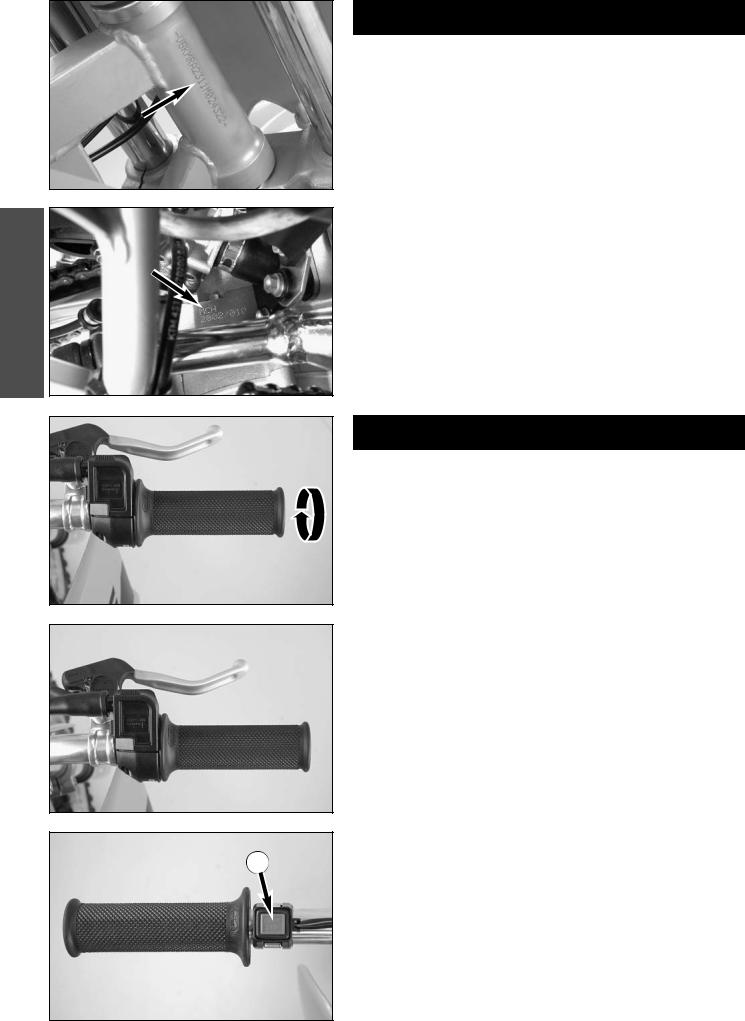
ENGLISH 6
SERIAL NUMBER LOCATIONS
Chassis number
The chassis number is located on the type plate on the steering head. Enter this number in the field on page no 1.
Engine number
The engine number is stamped into the right half of the engine case next to the kickstarter. Enter this number in the relevant field on page 1.
Engine typ
50 MCH
OPERATION INSTRUMENTS
Throttle grip
The throttle grip is located on the right side of the handlebars. It is used to reduce the engine speed and, thus, the driving speed.
Hand brake lever
The hand brake lever is located on the right side of the handlebars and actuates the front wheel brake. The basic position can be adjusted to fit your child's hand.
|
Short circuit button |
1 |
The short circuit button 1 turns off the engine. When pressing this button, |
the ignition circuit is short-circuited. |
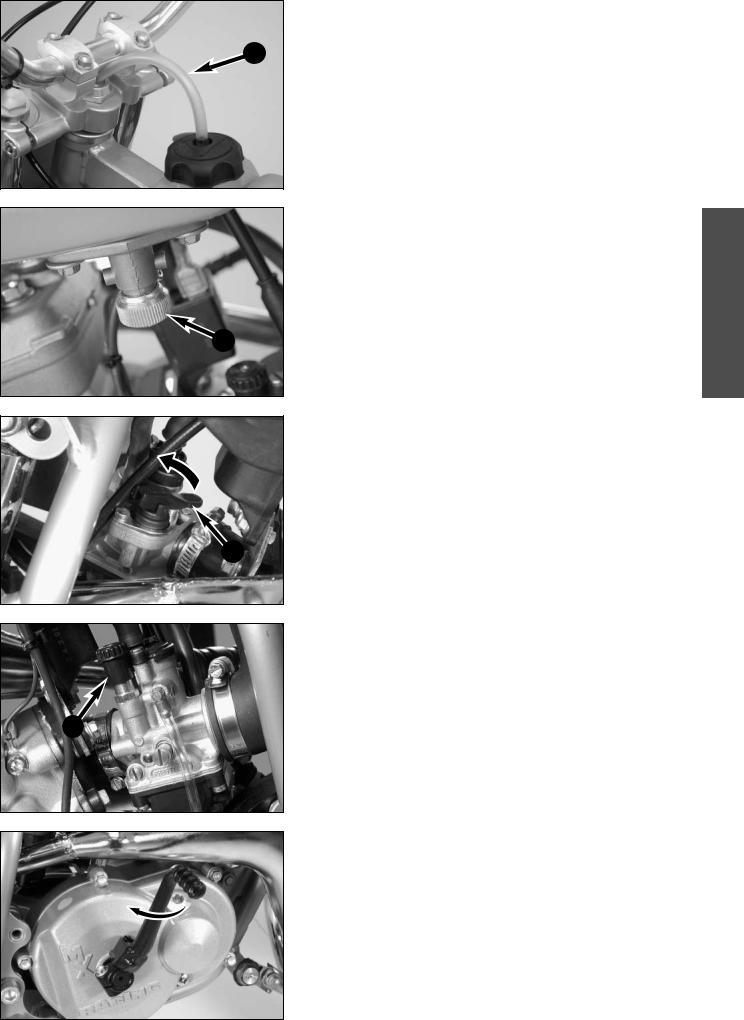
1
2
3
4
Filler cap
To open it: turn filler cap counter-clockwise.
To close it: put filler cap back on and tighten it by turning it clockwise.
Install tank breather hose 1 without kinks.
Fuel tap
The fuel tap 2 is located at the front of the motorcycle on the left side of the tank.
Opening the fuel tap: Turn the knob all the way to the left. Closing the fuel tap: Turn the knob all the way to the right.
Choke (Dell’Orto carburetor PHVA 14 DS)
Choke lever 3 is mounted to the right side of the carburetor. If you move the choke lever up to the stop, a hole is opened in the carburetor through which the engine can draw in additional fuel. This results in a "rich" fuel-air mixture required for a cold start.
Moving the choke lever back closes the hole in the carburetor again.
Choke (Dell’Orto carburetor PHBG 19 BS)
Choke control knob 4 is mounted to the left side of the carburetor. If you pull the choke control knob up to the stop and turn it 90º, a hole is opened in the carburetor through which the engine can draw additional fuel. This results in a "rich" fuel-air mixture required for a cold start.
Turning back the choke control knob returns the knob to the starting position and closes the hole in the carburetor again.
Kickstarter
The kickstarter is mounted on the right side of the engine. Its upper part can be swivelled.
NOTE: an accessory kit for kickstarter backwards operation is available.
ENGLISH 7

ENGLISH 8
1
2 |
Foot brake lever
The foot brake lever is located in front of the right footrest. The basic position can be adjusted to the seating position (see maintenance work).
Side stand
Use your foot to swing the side stand forwards to the stop. Make sure it rests securely on solid ground.
Plugin - Stand (50 SX PRO SENIOR)
A socket is provided on the left side of the frame for the plug-in stand 1 included in the scope of supply.
Rebound damping function of the shock absorber
The damping effect of the rebound damping mechanism can be adjusted by means of the setting wheel 2. Turn the setting wheel clockwise (in) to increase and counterclockwise (out) to reduce the damping effect.
STANDARD SETTING: 5 CLICKS OPEN
WARNING
–NEVER TURN THE SETTING WHEEL MORE THAN TWO CLICKS BETWEEN TWO TEST RIDES.
–DO NOT TRY TO DISASSEMBLE THE SHOCK ABSORBER OR TO PERFORM MAINTENANCE
WORK YOURSELF. DANGER OF INJURY!

ENGLISH
9

GENERAL TIPS AND WARNINGS FOR STARTING THE MOTORCYCLE
ENGLISH
10
Instructions for the first ride
–Verify that your KTM dealer performed the PREPARATION OF VEHICLE jobs (see Customer Service Manual).
–Before your youngster takes his or her first ride, explain how each of the controls works and check if your youngster has understood what you explained. We recommend to review the entire owner’s manual with your youngster item by item, paying particular attention to the specially marked warnings and pointing out the danger of injury.
–Adjust the basic position of the hand brake lever to fit the size of your child's hand. You child should of course wear gloves. Adjust the foot brake lever to your child's seating position.
–To prevent injury, teach your youngster the basic riding skills on soft ground, e.g. on a meadow or in the garden. Be sure that there is room enough to maneuver, and that no other riders are close.
–To ensure that your youngster gets the feel of the brakes, have your youngster operate the brakes while you push the motorcycle. Do not start the engine before your youngster has learned to apply both brakes with appropriate pressure.
–Now your youngster must get the feel of the throttle. Start the engine, hold the motorcycle and have your youngster slowly open the throttle. Then, your youngster can take his/her first ride. Initially, your youngster should ride back and forth between two persons who help the young rider to stop the motorcycle. However, you should also teach your youngster how to stop the motorcycle himself/herself.
–To improve his/her riding skills, your youngster should practise to ride the motorcycle standing on the footpegs or riding at the slowest possible speed. Additionally, you can arrange a series of obstacles and have your youngster drive around them, etc.
Tell your youngster to look 3-10 m ahead, depending on the speed, to recognize and avoid obstacles. When riding through curves, the rider should also look far ahead into the curve.
–Pay attention to running-in procedure.
|
WARNING |
|
– HAVE YOUR YOUNGSTER WEAR PROPER PROTECTIVE GEAR WHENEVER HE OR SHE RIDES THE MOTORCYCLE: HELMET, EYE PROTECTION, CHEST, BACK, ARM AND LEG PROTECTORS, GLOVES AND BOOTS. TO SET A GOOD EXAMPLE, BE SURE TO WEAR PROTECTIVE GEAR YOURSELF WHENEVER RIDING A MOTORCYCLE!
– THE MOTORCYCLE HAS A CENTRIFUGAL CLUTCH. THE MOTORCYCLE BEGINS TO MOVE AS SOON AS THE THROTTLE IS OPENED.
– ALWAYS APPLY THE FRONT BRAKE WHEN STARTING THE ENGINE AND RELEASE THE BRAKE SLOWLY WHEN THE ENGINE IS RUNNING. AN ACTIVA- TED CHOKE INCREASES THE IDLE SPEED OF THE ENGINE, THE CENTRIFUGAL CLUTCH THUS BEGINNING TO ENGAGE. THEREFORE, THE MOTORCYCLE CAN BEGIN TO MOVE WHEN THE BRAKE LEVERS ARE RELEASED.
– WHEN THE ENGINE SPEED DROPS TO THE LEVEL AT WHICH THE CENTRIFUGAL CLUTCH DISENGAGES, BRAKING WITH THE ENGINE IS NO LONGER POSSIBLE AND THE MOTORCYCLE CAN ONLY BE SLOWED DOWN USING THE BRAKES.
– YOUR CHILD SHOULD NEVER DRIVE FASTER THAN ITS SKILLS AND THE TERRAIN PERMIT.
–NEVER LET YOUR CHILD DRIVE ITS MOTORCYCLE UNCHAPERONED.
–REPLACE THE HELMET VISOR OR GOGGLE GLASSES EARLY ENOUGH. WHEN LIGHT SHINES DIRECTLY ON A SCRATCHED VISOR OR GOGGLES,
YOU WILL BE PRACTICALLY BLIND.
–ONLY USE ACCESSORY PARTS RECOMMENDED BY KTM.
–NEVER LEAVE YOUR MOTORCYCLE WITHOUT SUPERVISION AS LONG AS
THE ENGINE IS RUNNING.
|
WARNING |
|
–KTM MINI MODELS ARE DESIGNED FOR ONE PERSON ONLY. PASSENGERS ARE NOT ALLOWED.
–THESE MODELS DO NOT COMPLY WITH THE REGULATIONS AND SAFETY
STANDARDS ESTABLISHED BY THE LAW. THEREFORE, THEY ARE NOT PERMITTED ON PUBLIC ROADS.
– ALWAYS KEEP IN MIND THAT OTHER PEOPLE FEEL MOLESTED BY EXCESSIVE NOISE.
Running in
–Even very precisely machined sections of engine components have rougher surfaces than components which have been sliding across one another for quite some time. Therefore, every engine needs to be broken in. Do not load the engine to the power limit during the first half hour for this reason.
–Apply low but changing loads for running-in.
–NO FULL-LOAD OPERATION DURING THE FIRST HALF HOUR!
